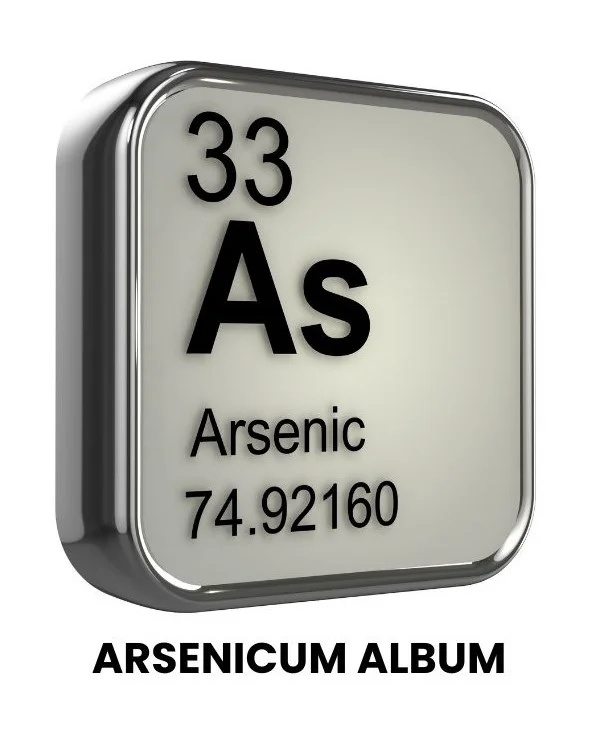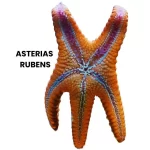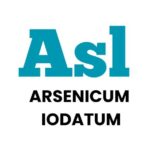Arsenic, a deadly poison, has been historically used in medicine. Its physiological dose induces vomiting, purging, and prostration.
It resembles a cholera patient, with burning sensations and a feeble pulse. Its distinct odour can identify an Arsenic patient.
Prover: HAHANEMANN
Table of Contents
ToggleSOURCE INFORMATION

Arsenicum Album, commonly known as White Oxide of Arsenic, is a chemical compound represented by the formula As₂O₃.
Chemical Composition: Arsenicum Album is composed of arsenic and oxygen atoms, with two atoms of arsenic (As) combined with three atoms of oxygen (O), hence the chemical formula As₂O₃.
Physical Properties: Arsenicum Album typically appears as a white, odorless powder or crystalline solid. It is insoluble in water but soluble in acids.
Toxicity: Arsenicum Album is highly toxic to humans and animals. Exposure to this compound can lead to severe health effects, including gastrointestinal issues, neurological damage, skin lesions, and even death in high doses.
Medical Uses: Despite its toxicity, Arsenicum Album has been historically used in traditional medicine, particularly in homeopathy.
In highly diluted and potentized forms, it is believed to have therapeutic effects for various ailments, including digestive disorders, respiratory conditions, skin diseases, and anxiety.
Chemical Reactions: Arsenicum Album can undergo chemical reactions, including oxidation and reduction processes.
It can react with acids to form arsenic salts and with reducing agents to release elemental arsenic.
Industrial Applications: Arsenicum Album is not commonly used in industrial applications due to its toxicity.
However, it has been historically employed in certain industries, such as glass manufacturing and pyrotechnics, albeit with extreme caution due to its hazardous nature.
SPHERES OF ACTION
- Mind and nerves.
- Mucous membranes.
- Joints and periosteum (the covering of bones).
- Liver and spleen.
- Lymphatic system.
- Blood.
- Lungs.
- Skin.
- Stomach.
- Alimentary canal (the digestive tract).
Notably, Arsenic tends to have a more rapid effect on vegetarians compared to non-vegetarians.
CLINICAL APPLICATION
Clinically, it is employed for various ailments including abscesses, alcoholism, asthma, cancer, cholera, cough, diarrhea, dropsy, fever, gangrene, heart issues, hemorrhoids, kidney problems, and more.
PATHOGENESIS
Arsenic is a poisonous substance that causes constant and severe irritation to different tissues in the body:
- It impacts the blood, leading to changes such as rashes, bruising, and small hemorrhages.
- It affects the digestive system, causing symptoms akin to Asiatic cholera.
- It affects veins, resulting in varicose veins that feel like they are burning, particularly at night.
- It affects glands, causing them to harden and form pus.
- It causes inflammation characterized by sharp, burning pains and swelling.
- It affects the lining of body cavities, leading to the production of large amounts of watery fluid.
- It affects the covering of bones, known as the periosteum.
- It affects joints, causing them to become pale, swollen, and painful.
- It can cause general swelling of the body, known as anasarca, with pale or waxy skin.
- It leads to rapid weight loss or wasting away.
- It can result in ulcers that burn intensely, producing foul-smelling discharges.
- It irritates the skin, causing severe itching and burning sensations, followed by rashes, sores, and other skin problems.
DOCTRINE OF SIGNATURE OF ARSENICUM ALBUM
The Doctrine of Signatures suggests that plants may bear a resemblance to the ailments they can treat, providing clues to their medicinal properties based on their physical characteristics.
In the case of the Arsenicum album, commonly known as arsenic, its Doctrine of Signature is derived from both its physical properties and its toxic nature.
White Appearance
- Arsenicum album is a white, odorless, and tasteless substance.
- This whiteness is often associated with purity and cleanliness, symbolizing the remedy’s potential to address conditions characterized by excessive discharges, such as watery diarrhea, nasal discharge, or vomiting.
- The color white may also symbolize the remedy’s ability to restore balance and clarity to the body and mind.
Toxicity
- Arsenicum album is highly toxic in its pure form, and even in highly diluted homeopathic preparations, it retains its medicinal properties.
- This toxicity is reflected in the Doctrine of Signature, suggesting that the remedy may have an affinity for treating conditions characterized by intense, burning pains, rapid deterioration, and extreme weakness.
- It may also indicate its potential to address symptoms associated with poisoning or toxic exposures.
CONSTITUTION
Physical Appearance: The Arsenic patient typically appears lean, thin, and debilitated, often exhibiting a hippocratic face and a dirty, waxy look to the skin.
Temperament: They are very fastidious individuals, preferring everything to be neat, clean, and orderly.
Relation with Temperature: Arsenic patients tend to feel chilly, experiencing internal chilliness and therefore craving heat, except in the outer head region.
Miasm: Arsenic encompasses elements of Psora, Syphilis, and Sycosis.
Diathesis: It is associated with the Scrofulous diathesis.
KEY SYMPTOMS
- Fear of Death: Arsenic patients harbour a great fear of death, often believing their condition to be incurable and fatal, leading them to doubt the efficacy of medications.
- Restlessness: They are mentally restless but physically too weak and exhausted to move about, displaying a characteristic restlessness akin to a horse.
- Burning Pain: Arsenic patients experience burning pain, which is relieved by heat except in the head. They may desire to keep their body warm while keeping the head cool.
- Prostration: Great prostration is persistently present, with a notable sinking of strength disproportionate to the severity of the illness.
- Gastric Derangements: Gastric issues such as diarrhea and vomiting arise from food poisoning due to spoiled eggs, fish, meat, decayed food, alcohol, or ice cream.
- Periodicity: Complaints often return periodically, making Arsenic useful in treating intermittent fever.
- Character of Discharges: All discharges are acrid, scanty, putrid, dark, and offensive, accompanied by a cadaverous odour.
- Thirst: Arsenic patients may have a thirst for small quantities of water at short intervals in acute states, but in chronic conditions, there may be no thirst.
- Ptomaine Poisoning: It is an excellent remedy for both acute and chronic ptomaine poisoning.
- Food Aversion: They cannot bear the smell or sight of food, similar to symptoms seen in Colchicum, Sepia, and Stannum.
- Aggravation and Amelioration: Symptoms worsen at midday and midnight (1 to 2 a.m./p.m.) and are relieved by heat.
AILMENTS FROM
- Chill: Ailments may arise from exposure to cold temperatures.
- Winter: The cold weather of winter can trigger ailments.
- Consumption of Cold Items: Ailments may result from consuming ice, ice-cream, or cold fruits.
- Decayed Food or Animal Matter: Ingesting or being exposed to decayed food or animal matter, whether by inoculation, olfaction, or ingestion, can lead to health issues.
- Poor Diet: Ailments may stem from a diet lacking in proper nutrition.
- Continued Drainage of Body Fluids: Prolonged drainage of body fluids can contribute to health problems.
- Anaemia: Ailments may arise from a condition of anaemia, characterized by a deficiency of red blood cells or haemoglobin.
- Abuse of Alcohol: Excessive alcohol consumption can lead to health issues.
- Sour Beer: Consumption of sour beer may trigger ailments.
- Bad Sausage: Ingesting spoiled or bad sausage can lead to health problems.
- Strong Cheese: Ailments may result from consuming strong or pungent cheese.
- Ptomaine Poisoning: Health issues can arise from ptomaine poisoning, caused by the ingestion of food containing bacterial toxins.
- Tobacco: Ailments may be triggered by the abuse or excessive use of tobacco products.
- Abuse of Quinine and Iodine: Overuse or abuse of quinine and iodine substances can lead to health problems.
- Climbing Mountains: Ailments may result from climbing mountains, possibly due to physical exertion or exposure to high altitudes.
- Sea Bathing: Health issues may arise from sea bathing, potentially due to exposure to seawater or environmental factors.
PARTICULARS
PSYCHOLOGICAL PROFILE OF ARSENICUM ALBUM PATIENTS
Personality Traits
- The Arsenicum Album individual is characterized by a deep-seated sense of insecurity and loneliness, feeling isolated and disconnected from others.
- Unlike Phosphorus, who compensates with excessive friendliness, the Arsenicum patient exhibits fear and insecurity.
- They perceive the world as threatening and chaotic, feeling old, weak, and defenceless, surrounded by potential threats.
- Despite their dependency on others due to their perceived weakness, they harbour mistrust and suspicion, believing that people are only interested in their money and cannot be trusted.
- This sense of vulnerability leads to cautiousness and anxiety in all aspects of life, including money, relationships, and health.
Health Anxiety
- Arsenicum Album individuals have hypochondriacal anxiety, constantly fearing the loss of health unless they adhere to strict routines and precautions.
- They avoid perceived harmful activities and impose strict dietary restrictions on themselves, leading to a life filled with anxiety and restlessness.
- The fear of losing what they have driven them to be extremely cautious and conscientious, resulting in restlessness and an almost compulsive need for order.
Behavioral Characteristics
- They exhibit extreme fastidiousness, requiring everything to be in order and meticulously arranged.
- The Arsenicum patient may engage in compulsive behaviors, such as repeatedly checking and adjusting things to ensure perfection.
- Despite their anxiety and restlessness, they may appear caring and attentive to the health and security of others, extending their concerns beyond themselves.
Emotional State
- The Arsenicum individual experiences profound depression, melancholy, and despair, accompanied by tears and a sense of anguish.
- They harbour a deep fear of death, particularly when alone or at night, contributing to their restless and anxious demeanor.
- While they may avoid social interactions due to fear of offending others, they also fear being alone, reflecting their inner turmoil and emotional instability.
- Dreams are often filled with themes of sorrow, fear, and death, further reflecting their anxious and distressed state of mind.
In summary, the Arsenicum Album patient presents a complex psychological profile characterized by deep-seated insecurity, hypochondriacal anxiety, extreme fastidiousness, and profound emotional turmoil, manifesting as restlessness, fear, and despair.
HEADACHE
- Causation: Exposure to cold, consuming ice cream, decayed food, loss of vital fluids, or alcohol abuse.
- Location: Periodical headache throughout the head, including congestion in the forehead.
- Character of Pain: Throbbing and burning sensation. Severe occipital headache leading to dazedness, with a feeling of brain vibration and looseness.
- Modalities: Aggravated by light, motion, and starting between 1-3 p.m., extending until midnight. Relieved by cold applications, in a dark room, and lying with the head on a pillow.
- Concomitants: Nausea and vomiting, chilly except in the head, alternating with physical symptoms during intermittent fever.
GASTRO-INTESTINAL SYMPTOMS
Mouth
- Bleeding gums and bad breath.
- Sore lips, mouth ulcers, and eruptions.
- Foul-smelling and bloody saliva with mouth sores.
- Tongue appears blackish, brown, or dry with red streaks and papillae.
- Dry mouth with excessive thirst but drinking in small amounts frequently.
- Throat: Ulcerated, swollen, and dry with soreness, scraping, and burning, making swallowing difficult and painful.
Stomach
- Dislike and intolerance towards food.
- Burning pain and pressure in the stomach, especially after eating.
- Anxiety and restlessness with rolling movements due to stomach discomfort.
- Nausea and vomiting immediately after ingesting anything, with vomit dark, offensive, and putrid.
- Vomiting of food, water, and bile, often followed by diarrhea and profound weakness.
- Spasmodic colic with a sensation of twisted intestines and burning abdomen.
- Fear of death and worsened symptoms during mid-day and midnight.
Cholera
- Triggered by consuming cold items, decayed food, or bad sausage during cholera outbreaks.
- Stools are dark, black, watery, offensive, and rice-water-like, with intense vomiting and weakness.
- Corrosive stool with cutting pain and burning in the anus and rectum, worse at midnight.
- Diarrhea characterized by offensive odour, pain, and weakness, accompanied by anguish and fear of death.
Hemorrhoids
- Painful hemorrhoids with stitching pain while walking or sitting, relieved by heat.
RESPIRATORY SYSTEM
Asthma
- Onset or worsening triggered by suppressed eruptions, cold items, and chilled food.
- Patient experiences intense worry and anguish.
- Unable to lie down due to fear of suffocation, must sit or bend forward with arms abducted for relief.
- Wheezing breaths accompanied by cough and frothy expectoration.
- Darting pain in the upper third of the right lung worsened by cold drinks or food.
- Scanty, frothy, offensive, and dark sputum.
- Breathlessness immediately upon lying down, with a whistling sound from tracheal constriction.
- Chest tightness as if bound with a hoop, especially aggravated from 12-2 a.m./p.m.
- General relief experienced from warmth.
CARDIOVASCULAR SYSTEM
Palpitations
- Follow suppression of foot sweat or tonsillitis treated with Baryta carb.
- Heart beats faster and stronger when lying on the back.
- Arsenic is beneficial in cases of Angina Pectoris.
- Sudden tightness and agonizing pain in the chest radiating to the back, occiput, and neck.
- Angina pain worsens from 12-2 a.m.
- Pulse is weak, thread-like, and incompressible.
SKIN
- Skin appears pale and pasty, with painful black eruptions.
- Presence of pustules, vesicles, and shedding of skin from head to foot.
- Burning and itching sensations, followed by pain upon scratching.
- Pimples cause intense burning, leading to unbearable anguish.
- Dropsy may occur locally or generally, accompanied by disproportionate weakness.
- Black vesicles result in burning pain.
- Carbuncles, boils, and abscesses with a very foul-smelling discharge that is hot and burning, but relieved by hot applications.
- Cancers cause severe pain.
- In cases of gangrene, burning pain is alleviated by heat.
INTERMITTENT FEVER
- Types include quotidian, tertian, quartan, and double tertian fevers.
- Episodes anticipated every 14 days, annually.
- Remittent and relapsing fevers such as typhoid and malaria, often due to excessive use of quinine derivatives.
- Paroxysms typically occur in the afternoon (1-2 a.m. and 12-2 p.m.).
- Prodromal symptoms may include sleepiness the night before, accompanied by yawning, stretching, malaise, debility, weakness, headache, and vertigo.
- Chills occur without thirst and alternate with heat.
- Preference for dry heat and thirst, with a tendency to uncover.
- Sweating occurs at the end of the fever, relieving pain; characterized by cold, clammy sweat with a sour and offensive odour. Thirst is experienced during the sweating stage.
GENERAL MODALITIES
Aggravation
- Symptoms worsen periodically after mid-day and midnight, specifically between 12-2 a.m./p.m.
- Aggravated by consuming cold food and drinks.
- Exacerbated by exertion and lying on the affected side with the head positioned low.
Amelioration
- Relief is experienced from warmth in general, except for the head, which is temporarily alleviated by cold.
- Improvement is noted with the intake of hot drinks and application of heat.
- Motion and elevating the head provide relief.
- Company and rest contribute to amelioration.
WHAT ARE MODALITIES IN HOMOEOPATHY?
RELATION WITH OTHER REMEDIES
- Complementary to Sulphur, Thuja, Rhus tox., Carbo veg., Phos, and Secale cor.
- Antidotes: Camphor, Carbo veg., Graphites, China, Hepar, Ipecac, and Nux vom.
DOSAGE
Arsenicum album is typically administered in potencies ranging from the third to thirtieth potency.
The highest potencies often provide excellent outcomes.
In gastric, intestinal, and kidney diseases, lower attenuations are preferred, while higher potencies are used for neuralgias, nervous disorders, and skin conditions.
For surface ailments, such as skin issues, lower potencies like 2x to 3x triturations are recommended.
Repeat doses may be necessary depending on the case.













Leave a Reply